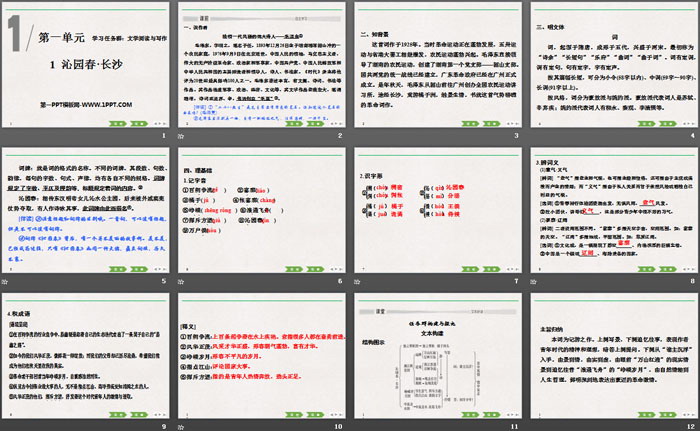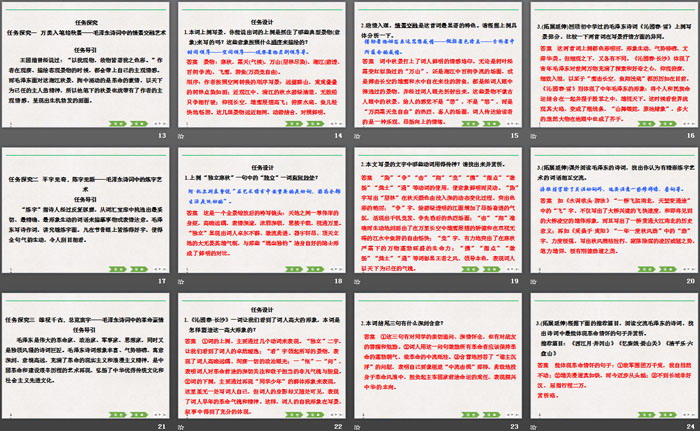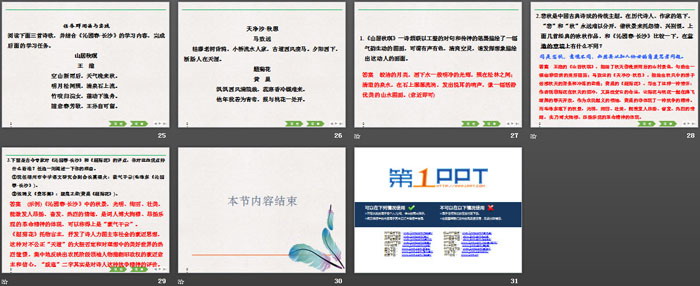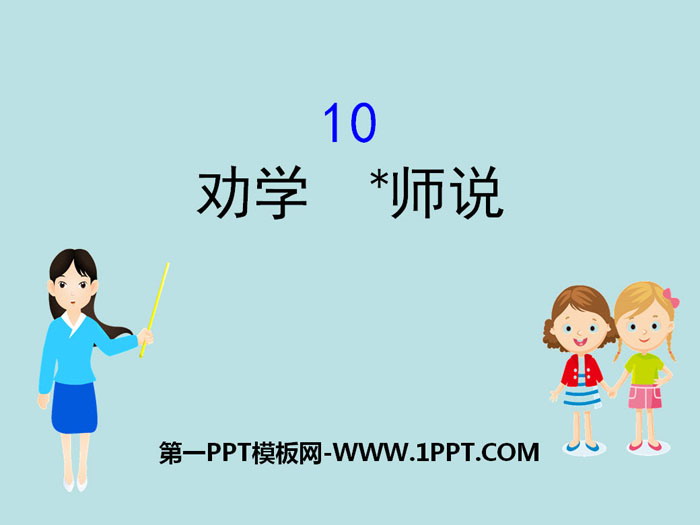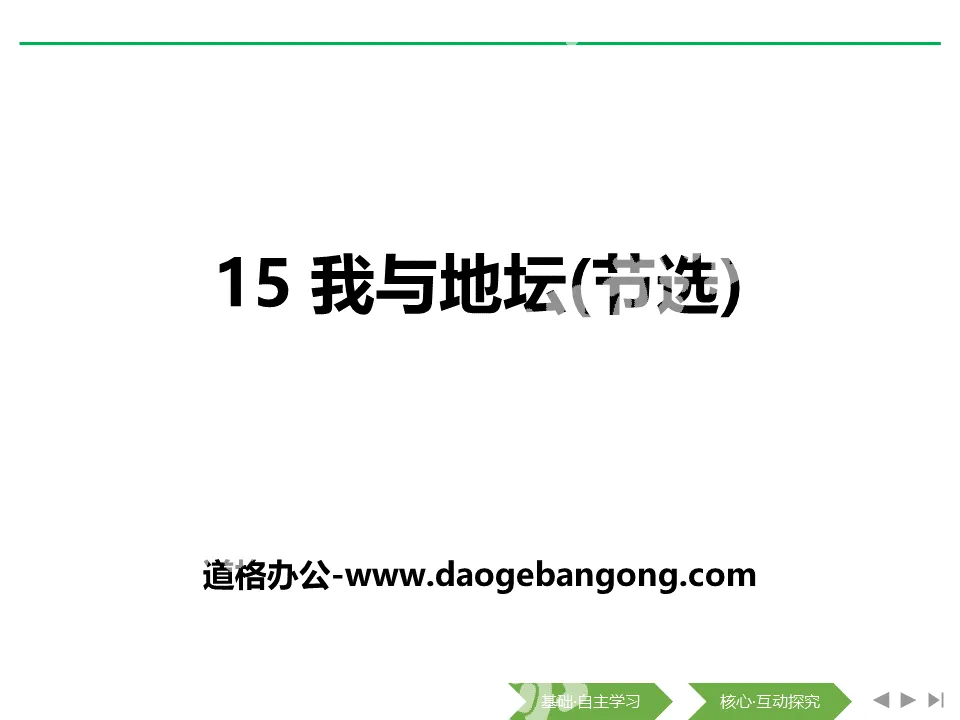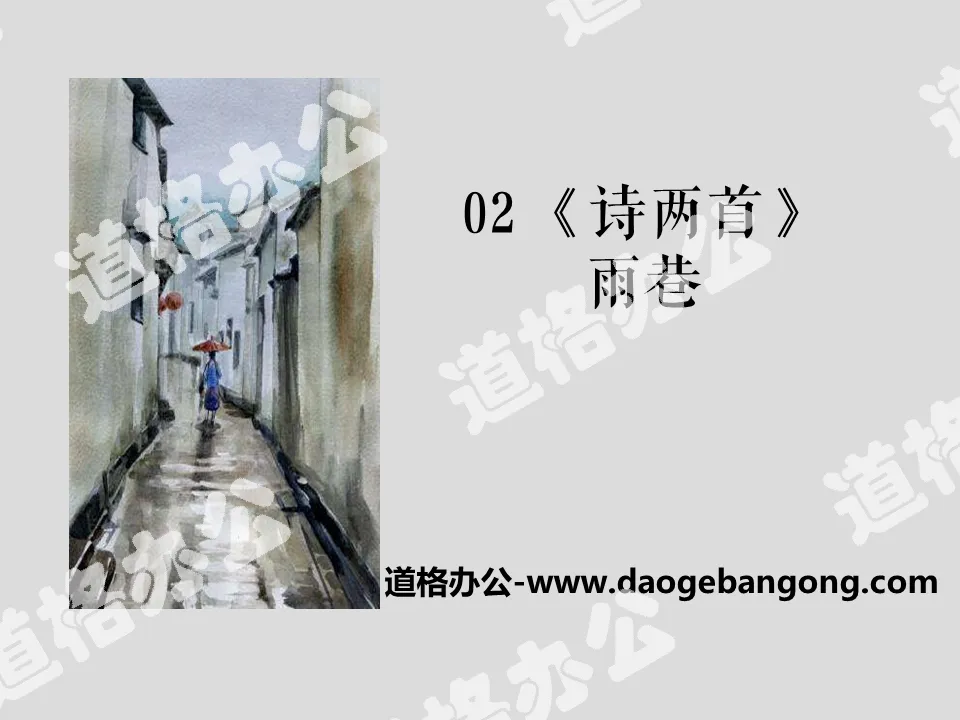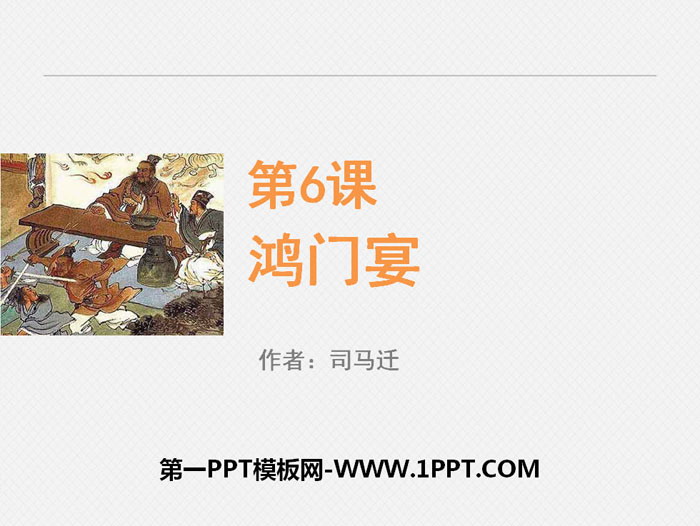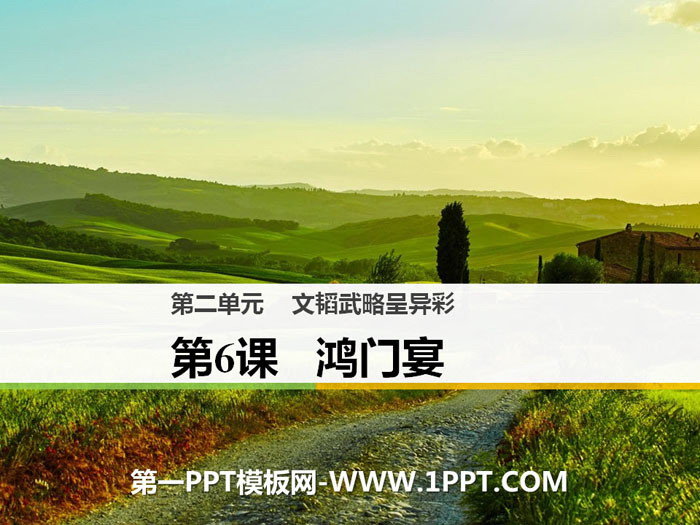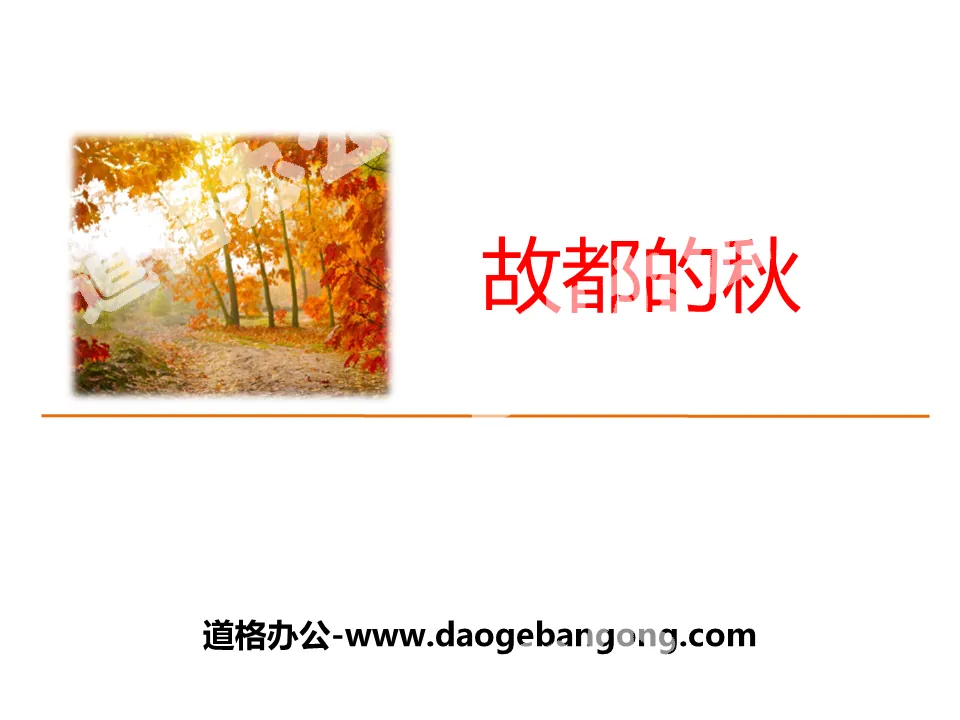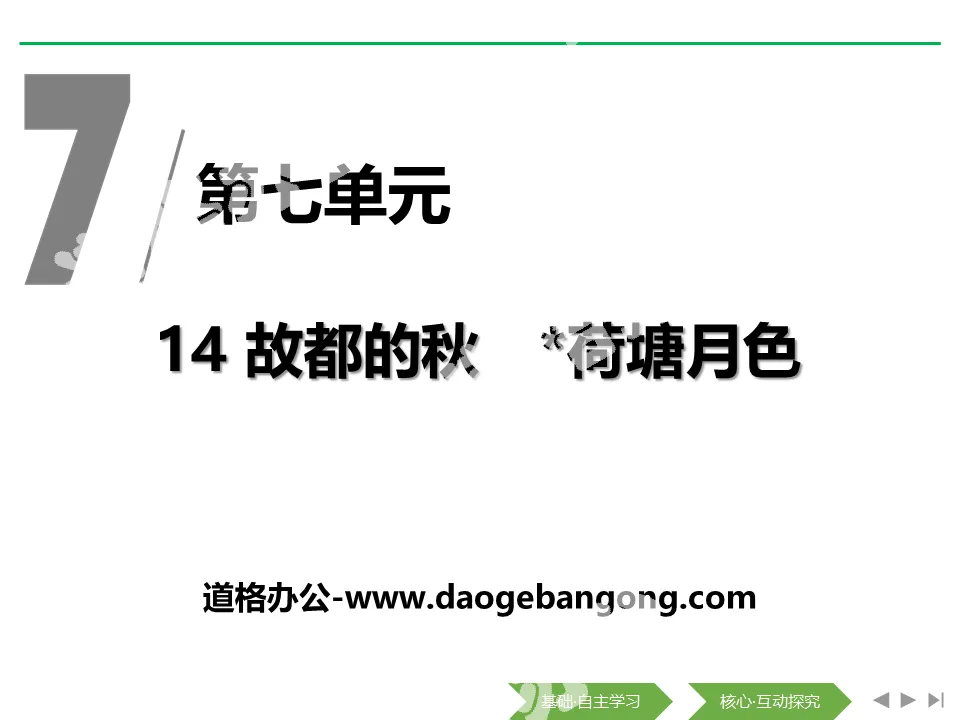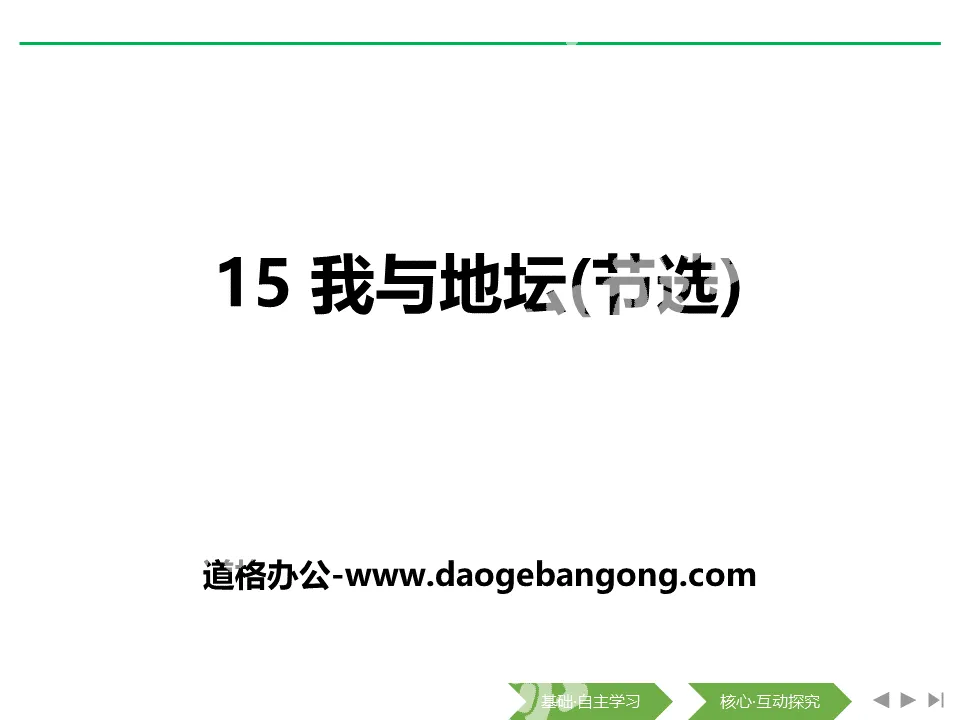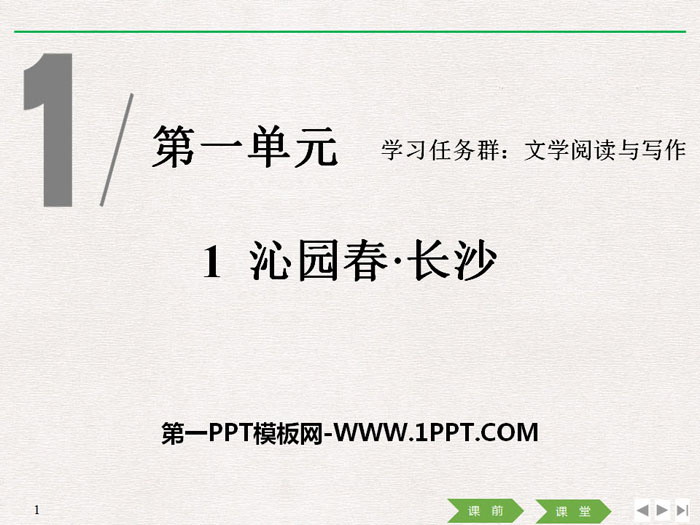
| Category | Format | Size |
|---|---|---|
| People's Education Press High School Chinese Compulsory Course 1 | pptx | 6 MB |
Description
"Qinyuanchun·Changsha" PPT high-quality courseware
Contents of Part One: 1. Understanding the Author
The great poet who led the generation—Mao Zedong①
Mao Zedong, whose courtesy name was Runzhi and whose pseudonym was Ziren. Born in a peasant family in Shaoshanchong, Xiangtan, Hunan on December 26, 1893, he died in Beijing on September 9, 1976. The leader of the Chinese people, a Marxist, a great proletarian revolutionist, politician and militarist, the main founder and leader of the Communist Party of China, the Chinese People's Liberation Army and the People's Republic of China, a poet and calligrapher. Time magazine named him one of the 100 most influential people of the 20th century. Mao Zedong wrote extensively, including anthologies, poems, calligraphy and other works. His works cover military, politics, economy, culture, etc. His literary works have grand artistic conception and vigorous writing style. His poems directly follow Su and Xin, and his calligraphy created "Mao Cao"②.
[Companion Reading] ①"Twenty-Eight Painters" is Chairman Mao's most distinctive pen name. Do you know the origin of this pen name? (gross)
②Mao Zedong's calligraphy has a unique style, with a majestic and unrestrained spirit that can spread thousands of miles.
Qinyuanchun Changsha PPT, the second part of the content: 2. Know the background
This poem was written in 1925. At that time, the revolutionary movement was booming. The May 30th Movement and the provincial and Hong Kong strikes broke out one after another, and the peasant movement was booming. Mao Zedong directly led the peasant movement in Hunan and founded the first party branch in Hunan, the Shaoshan branch. The united front of the Kuomintang and the Communist Party has been established, and the Guangdong Revolutionary Government has been formally established in Guangzhou. In the autumn of that year, Mao Zedong went from Shaoshan to Guangzhou to establish the National Peasant Movement Workshop. He passed through Changsha and revisited Juzizhou. He was so moved by the scene that he wrote this majestic revolutionary poem.
Qinyuanchun Changsha PPT, the third part of the content: 3. Mingwen style
word
Ci originated in the Sui and Tang Dynasties, took shape in the Five Dynasties, and flourished in the Song Dynasty. It was originally called "Shiyu", "Long and Short Sentences", "Yuefu", "Quci" and "Quci". The words have a definite tone, the tone has a definite sentence, the sentence has a definite character, and the words have a definite tone.
According to its length, it can be divided into Xiaoling (within 58 characters), Zhongdiao (59 to 90 characters), and Long Diao (more than 91 characters).
According to style, Ci is divided into bold and graceful styles. The representative poets of the Bold and Unconstrained School are Su Shi and Xin Qiji; the representative poets of the Graceful School include Liu Yong, Qin Guan, Li Qingzhao, etc.
Word card: It is the name of the word format. Different word cards have different specifications in terms of the number of paragraphs, sentences, rhythm, number of words in each sentence, sentence structure, and pronunciation. The word card stipulates the number of words, equivalence, rhyme, etc., and the title stipulates the content of the word. ③
Qinyuanchun: According to legend, the garden of Princess Qinshui, the daughter of Emperor Ming of the Eastern Han Dynasty, was later seized by his relative Dou Xian. Some people wrote poems about it, and this word plaque got its name from this④.
[Reading] ③Pay attention to the difference between the title and the word card. A word can have no title, but it cannot have a word card.
④Behind the Ci Pai "Qinyuan Chun", there is a story that is not beautiful. Whether it is beautiful or not has become a thing of the past. Only "Qinyuanchun" stands like a big flag in the world of poetry and will last forever.
Qinyuanchun Changsha PPT, part 4 content: 4. Physics foundation
1. Remember the pronunciation
①Hundreds of boats competing against each other () ②Liao Kuo ()
③Orange () ④Sad and lonely ( )
⑤Zhengrong() ⑥The waves stop the flying boat()
⑦Shu Fang Qiu() ⑧Qin Yuanchun()
⑨Wanhuhou ()
2.Learn glyphs
3. Distinguish the meaning of words
(1)Vigor and loyalty
[Bianci] "Yiqi" refers to will and spirit, and can also refer to interests and character, and can also refer to emotions arising from subjectivity or extremes; while "loyalty" refers to the willingness to take risks or The spirit of sacrificing one's own interests.
[Word selection] ①The Youth Cycling Experience Group set out in full gear, fearless of wind and rain, and _______ the wind.
②It is a very bad habit among some teenagers to form small groups and talk about buddies_______.
(2) Lonely and vast
[Word identification] The two have different scopes of application. "Liaokuo" mostly refers to the sky, the universe, and the scope of space. Such as: the vast sky. "Extensive" mostly refers to territory and plane scope. For example: The grassland is vast.
[Word selection] ①Cultural City is a huge treasure scroll that shows the blue sky _______ and has profound connotations.
②China is a country with ________ territory, both sea and land.
Qinyuanchun Changsha PPT, the fifth part: summary of the main theme
This poem is a travelogue. The upper column describes the scene, the lower column recalls the past, expresses the spirit and ideals of the author's youth, and secretly answers the upper column's questions. The next chapter starts from "who is in charge of the ups and downs", from scenery to emotion, from reality to virtuality, from the realistic scene of "thousands of mountains are red" in front of us to recalling the "turbulent years" in the past when "the waves stopped the flying boats", from natural taste to The philosophy of life clearly and profoundly expresses the heroic revolutionary passion.
Qinyuanchun Changsha PPT, Part Six: Task Research
The task is to explore ten thousand types of autumn scenery - the art of blending scenes in Mao Zedong's poems
Mission guidance
Wang Guowei once said: "When I observe things, the old objects all have my color." When the author observes and depicts objective scenery, he will bring his own subjective emotions. When Mao Zedong faced the autumn scenery of the Xiangjiang River, what surged in his chest was the revolutionary pride and the spirit of ownership of the world as his own responsibility. Therefore, the autumn scenery in his paintings also carries the author's subjective emotions, presenting a vibrant picture.
mission design
1. The upper part of this poem describes the scenery. Can you tell which typical scenery (imagery) is captured in the upper part of the poem? In what order are these images depicted?
Temporal order - spatial order - observed scene category order, etc.
Answer: Scenery: cold autumn, frosty weather (climate), thousands of mountains (all the forests are dyed), the Xiangjiang River (clear blue, hundreds of boats competing for the flow), flying eagles, and swimming fish (all kinds of fish compete freely).
Sequence: The author writes the scene in the order of space transformation: looking at the mountains from a distance, the overlapping woods are colorful and picturesque; looking at the river from a closer look, the autumn water in the river is green and clear, and countless ships are vying to sail; looking up at the sky, the eagles are flying high. ; Looking down at the bottom of the water, fish swim briskly. These groups of scenery alternate between far and near, combining movement and stillness, creating a sharp contrast.
2. The most striking feature of this poem is the blending of emotions and situations. Please analyze it in detail based on the above paragraph.
Use descriptions of scenery to express thoughts and feelings—summarize the characteristics of the scenery—and analyze the emotions contained in the scenery.
Answer: The autumn scene in the poem is marked by the poet’s distinct emotional imprint. Whether it is the "Ten Thousand Mountains" where the leaves turn red as if they have been dyed by frost, or the scene of hundreds of boats competing in the Xiangjiang River, or the eagles fighting in the sky and the fish swimming freely in the water, they are all filtered through the eyes of the poet. The scenery is reflected through the eyes of the poet. These scenery are not like the autumn scenery in the eyes of the ancients. They do not give people the feeling of "sadness" or "sadness", but a warm and joyful scene of "all kinds of frost and sky competing for freedom". What the poet conveys to the readers is an optimism, High spirits.
3. (Extended) Review the scene description section of Mao Zedong's poem "Qinyuanchun·Snow" that you have learned in junior high school, and compare the similarities and differences between the two poems in describing the scene and expressing emotions.
Answer: Both of these two poems have bright colors, vivid images, majestic momentum, and gorgeous diction. But upon closer inspection, they are all different. "Qinyuanchun·Changsha" embodies the young Mao Zedong's full of exploration and curiosity about all things in the world. He looks up and down with meticulous attention to detail, so that "the eagle strikes the sky and the fish flies to the shallow bottom" is still vivid in the present. "Qinyuan Chun·Snow" embodies the image of middle-aged Mao Zedong: combining personal and national destiny and holding it in the palm of his hand, he dominates the world. At this time, when he looked at the world, he saw it roughly, turning it into thick lines, "Silver snakes dancing in the mountains, wax elephants riding in the mountains", and the behemoths were like mustard seeds in his eyes.
Task 2: Common characters are strange, old characters are new - the art of character refining in Mao Zedong’s poems
Mission guidance
"Refining words" means that the poet selects the most appropriate, precise, and vivid words from the vocabulary treasure house to describe things or express feelings after repeated pondering. When Mao Zedong wrote poems and lyrics, he paid attention to tempering the words. Every detail of the sentence is well-crafted, making the whole sentence vivid and impressive.
mission design
1. What is the beauty of the word "independence" in the sentence "Independence in the Cold Autumn" above?
A. Tolstoy once said, "The most important thing in the language of art is verbs, because all life is in motion."
Answer: This is a close-up shot after panoramic zooming: a majestic body between heaven and earth, with a high vision, a profound expression, thick eyebrows and deep frown, thinking for thousands of years, and seeing thousands of miles. "Independence" shows the poet's fearless and heroic spirit of being outstanding, bravely advancing in the rapids, majestic and indomitable, forming a sharp contrast with those hermits who "sit alone and fish".
2. Which verbs are used expressively in the description of scenes in this article? Please find it and appreciate it.
Answer: The use of verbs such as "dye", "fight", "strike", "fly", "compete", "carry", "point", "encourage", "dung soil", and "contain", etc., make the image vivid and vivid. The word "dye" describes the dynamic change process of the color of the "layered forest" from light to dark in autumn, highlighting the gorgeous colors; the word "zheng" adds a high-spirited and enterprising atmosphere to the green and transparent river surface, vividly showing the spirit of thousands of sails competing for the first place. The lively scene; "strike" and "fly" accurately and vividly depict the vigor of the eagle spreading its wings in the sky thousands of miles long and the freedom of the fish swimming in the unobstructed river; the word "Jing" effectively highlights the The vigorous vitality of all things under the severe frost of cold autumn; words such as "carry", "guidance", "stimulate", "dung soil" and "contain" show the king's style and leadership qualities, and express the poet's courage to take the world as his own responsibility.
3. (Extension) Read Mao Zedong’s poems outside class, find words that you think have wonderful calligraphy skills, and communicate with each other.
In addition to paying attention to verbs when refining poetry, you also need to pay attention to some modifiers, repeated words, etc.
The answer is like the word "fly" in "A bridge flies to the north and south, and the chasm becomes a thoroughfare" in "Shui Tiao Ge Tou·Swimming", which not only describes the rapid construction speed of the bridge and the majestic image of the bridge that will be seen in the sky, but also It writes about the historical significance of a bridge connecting the north and south of the Yangtze River; another example is the word "jin" in "The Annual Autumn Wind" in "Picking Mulberries·Double Ninth Festival". The momentum of the writing is strong and powerful, and it has the beauty of vigor and strength.
Keywords: Free download of PPT courseware for high school Chinese compulsory course I published by People's Education Press, Qinyuanchun Changsha PPT download, .PPT format;
For more information about the "Qinyuanchun Changsha" PPT courseware, please click the "Qinyuanchun Changsha" ppt tag.
"Qinyuanchun·Changsha" PPT high-quality courseware download:
"Qinyuanchun Changsha" PPT high-quality courseware download Part 1: Reading some cultural knowledge (1) Ci Ci is a different style of poetry, which originated in the Sui and Tang Dynasties and became popular in the Song Dynasty. It is also called Shiyu, long and short sentences, Yuefu, Ququ Ci, etc. The characteristics of the word are that the word has a definite tone, the tone has a definite sentence, and the sentence...
"Qinyuanchun·Changsha" PPT quality courseware:
The first part of the PPT courseware "Qinyuanchun Changsha": [Reading Expo] 1. Mao Zedong, a politician with charming writer and poet feelings Mao Zedong (18931976), Marxist, great proletarian revolutionist, strategist and theorist, China Communist Party, China...
"Qinyuanchun·Changsha" PPT free download:
"Qinyuanchun Changsha" PPT free download Part 1: Situation introduction In the history of Chinese poetry, the first poet to extensively depict the beauty of nature and combine the description of natural beauty with concern for the fate of the country and the people was Qu Yuan. This is Chinese classical poetry..
File Info
Update Time: 2024-07-01
This template belongs to Chinese courseware People's Education Press High School Chinese Compulsory Course 1 industry PPT template
"Qinyuanchun·Changsha" PPT high-quality courseware Simple campus recruitment activity planning plan summary enterprise and institution recruitment publicity lecture PPT template is a general PPT template for business post competition provided by the manuscript PPT, simple campus recruitment activity planning plan summary enterprise and institution recruitment promotion Lecture PPT template, you can edit and modify the text and pictures in the source file by downloading the source file. If you want more exquisite business PPT templates, you can come to grid resource. Doug resource PPT, massive PPT template slide material download, we only make high-quality PPT templates!
Tips: If you open the template and feel that it is not suitable for all your needs, you can search for related content "Qinyuanchun·Changsha" PPT high-quality courseware is enough.
How to use the Windows system template
Directly decompress the file and use it with office or wps
How to use the Mac system template
Directly decompress the file and use it Office or wps can be used
Related reading
For more detailed PPT-related tutorials and font tutorials, you can view: Click to see
How to create a high-quality technological sense PPT? 4 ways to share the bottom of the box
Notice
Do not download in WeChat, Zhihu, QQ, built-in browsers, please use mobile browsers to download! If you are a mobile phone user, please download it on your computer!
1. The manuscript PPT is only for study and reference, please delete it 24 hours after downloading.
2. If the resource involves your legitimate rights and interests, delete it immediately.
3. Contact information: service@daogebangong.com
"Qinyuanchun·Changsha" PPT high-quality courseware, due to usage restrictions, it is only for personal study and reference use. For commercial use, please go to the relevant official website for authorization.
(Personal non-commercial use refers to the use of this font to complete the display of personal works, including but not limited to the design of personal papers, resumes, etc.)
Preview

